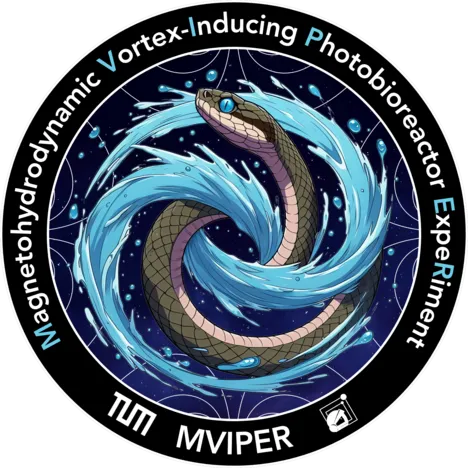
The Magnetohydrodynamic Vortex-Inducing Photobioreactor Experiment (MVIPER) is a student project that is highly supported by the professorship. It has been selected for participation in a parabolic flight campaign in September 2025 as part of the ESA Academy Experiments Programme 2024/2025 by the European Space Agency.
MVIPER aims to advance bioregenerative life support systems for future crewed long-term space missions. The project investigates a novel photobioreactor (PBR) concept for microalgae cultivation in space, where the conductivity of the algae nutrient solution is utilized to create a magnetohydrodynamic (MHD) drive within a circular reactor geometry. The driving force is the Lorentz force, which arises when the conductive liquid is exposed to an electric and perpendicular magnetic field, propelling the liquid. With the induced swirling motion, a vortex is created within the PBR chamber, enabling phase separation by forcing the liquid to the outside and gas bubbles to the inside, where a stable liquid-gas interface forms. As an advantage, the new PBR technology would require no moving parts and no membranes for phase separation in space, which can reduce the maintenance time and the mechanical stress on the algae.
As part of the ESA Academy Experiments Programme, MVIPER aims to study the flow behavior within a small-scale PBR in microgravity conditions during a parabolic flight of the Novespace A310 Zero-G. Specifically, the angular speed, flow characteristics, and bubble-moving dynamics of a magnetohydrodynamically induced vortex in an algae-suitable nutrient solution are studied. The objectives can be summarized as follows:
- Scientific objectives:
- Demonstrate the acceleration of a nutrient solution in a microgravity environment utilizing the MHD drive technology.
- Demonstrate the phase separation in a microgravity environment utilizing the MHD drive technology.
- Investigate the design characteristics and validate models for future system modeling and sizing.
- Educational objectives:
- Learn and experience the planning, development, and operation of experiments in microgravity science.
- Pass the gained knowledge and experience to current and future students of the Technical University of Munich and beyond.
Follow us on Social Media to stay updated:
Events:
We will be on the Space Day 2025 at the TUM Campus in Ottobrunn on saturday, April 12th, 2025. Come by and say hello!